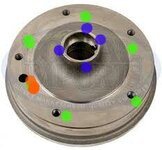FreeBirdTim
Silver Member
- Sep 24, 2013
- 3,844
- 6,911
- 🥇 Banner finds
- 1
- Detector(s) used
- Garrett AT Pro
- Primary Interest:
- All Treasure Hunting
Follow along with the video below to see how to install our site as a web app on your home screen.
Note: This feature may not be available in some browsers.
Found a couple of old auto parts in the woods today. Here's the first one. Is it a brake drum? Water pump? Guesses?
View attachment 1142036View attachment 1142037
Looks like VW brake drum is the winner!View attachment 1142706
 , so that's poo pooed too, and I notice what looks like an inspection port (red) that isn't on the adapter either.
, so that's poo pooed too, and I notice what looks like an inspection port (red) that isn't on the adapter either.
That key has nothing to do with brakes...the drum is bolted to the wheel, not transferred through the keyway.
Sent from a empty soda can!